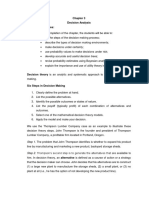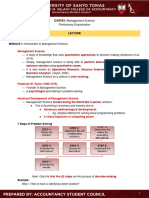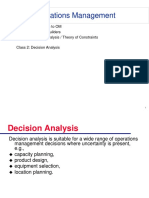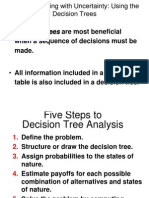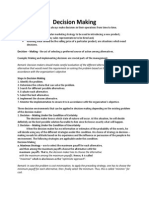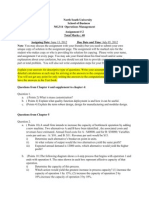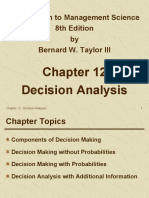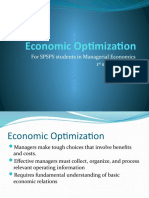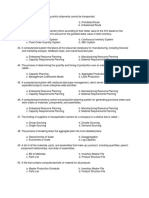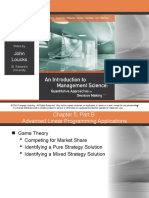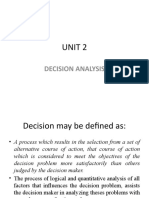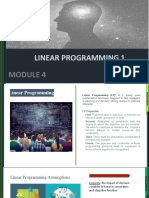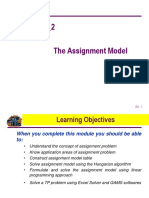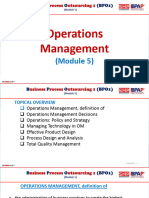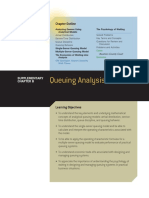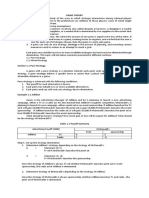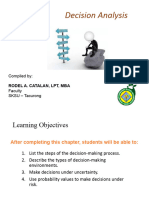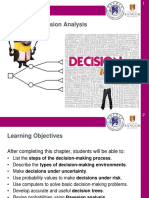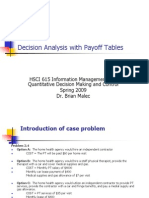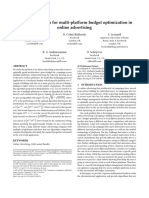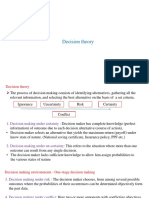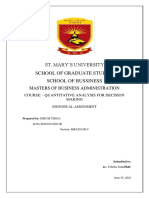Topic 1
Decision Analysis
(Chapter 3)
Source: Render et al., 2012. Quantitative Analysis Management, 11 editions, Pearson.
�Learning Objectives
Students will be able to:
List the steps of the decision-making process.
Describe the types of decision-making
environments.
Make decisions under uncertainty.
Use probability values to make decisions
under risk.
�Chapter Outline
3.1
3.2
3.3
3.4
3.5
3.6
3.7
Introduction
The Six Steps in Decision Theory
Types of Decision-Making Environments
Decision Making under Uncertainty
Decision Making under Risk
Decision Trees
How Probability Values Are Estimated by
Bayesian Analysis
3.8 Utility Theory
�Introduction
Decision theory is an analytical and
systematic way to tackle problems.
A good decision is based on logic.
�The Six Steps in Decision Theory
1.
2.
3.
4.
Clearly define the problem at hand.
List the possible alternatives.
Identify the possible outcomes.
List the payoff or profit of each
combination of alternatives and outcomes.
5. Select one of the mathematical decision
theory models.
6. Apply the model and make your decision.
�Example: Thompson Lumber Company Case
John Thompson is the founder and president
of Thompson Lumber Company, a profitable
firm located in Portland, Oregon.
The problem that John Thompson identifies is
whether to expand his product line by
manufacturing and marketing a new product,
backyard sheds.
�Example: Thompson Lumber Company Case
Define problem
To manufacture or market backyard storage
sheds
List alternatives
1.
2.
3.
Identify outcomes
The market could be favorable or unfavorable
for storage sheds
List payoffs
List the payoff for each state of nature/decision
alternative combination
Select a model
Decision tables and/or trees can be used to solve
the problem
Apply model and make
decision
Solutions can be obtained and a sensitivity
analysis used to make a decision
Construct a large new plant
A small plant
No plant at all
�Example: Thompson Lumber Company Case
Decision Table
State of Nature
Alternative
Favorable
Market ($)
Unfavorable
Market ($)
Construct a large plant
200,000
-180,000
Construct a small plant
100,000
-20,000
Do nothing
�Types of Decision-Making Environments
Decision making under certainty.
Decision maker knows with certainty the
consequences of every alternative or decision
choice.
Decision making under uncertainty.
The decision maker does not know the
probabilities of the various outcomes.
Decision making under risk.
The decision maker knows the probabilities of
the various outcomes.
�Decision Making under certainty:
Decision makers know within certainty the
consequence of every alternative or decision
choice.
E.g.: You have $1000 to invest for a 1-year
period. Alternatives are to open a savings or a
fixed deposit account paying 3% or 5% interest
per year respectively. If both investments are
secure and guaranteed, there is a certainty that
a fixed deposit will pay a higher return.
�Decision Making under Uncertainty: Criteria
Optimistic (Maximax)
Pessimistic (Maximin)
Criterion of Realism (Hurwicz)
Equally likely (Laplace Criterion)
Minimax Regret (Opportunity Loss or Regret)
�Decision Making under Uncertainty
Example: Thompson Lumber Company Case.
State of Nature
Alternative
Favorable
Market ($)
Unfavorable
Market ($)
Construct a large plant
200,000
-180,000
Construct a small plant
100,000
-20,000
Do nothing
�Decision Making under Uncertainty:
Optimistic (Maximax) Criterion
Example: Thompson Lumber Company Case
State of Nature
Alternative
Maximum in
Row
Favorable
Market ($)
Unfavorable
Market ($)
Construct a large
plant
200,000
-180,000
Construct a small
plant
100,000
-20,000
100,000
Do nothing
200,000
Optimistic
(Maximax)
�Decision Making under Uncertainty:
Pessimistic (Maximin) Criterion
Example: Thompson Lumber Company Case
State of Nature
Alternative
Minimum in
Row
Favorable
Market ($)
Unfavorable
Market ($)
Construct a large
plant
200,000
-180,000
-180,000
Construct a small
plant
100,000
-20,000
-20,000
Do nothing
Pessimistic
(Maximin)
�Decision Making under Uncertainty:
Criterion of Realism (Hurwicz) Criterion
Weighted Average = (best in row) + (1- ) (worst in row)
where: is the coefficient of realism (or the degree of optimism of the
decision maker), 0 1.
Example: Thompson Lumber Company Case (given = 0.8)
State of Nature
Favorable
Market ($)
Unfavorable
Market ($)
Weighted
Average in
Row
( = 0.8)
Construct a large
plant
200,000
-180,000
124,000
Construct a small
plant
100,000
-20,000
Alternative
Do nothing
Criterion
of Realism
76,000 (Hurwicz)
�Decision Making under Uncertainty:
Equally likely (Laplace) Criterion
Assume all states of nature to be equally likely, choose
maximum Average.
Example: Thompson Lumber Company Case
State of Nature
Alternative
Average in
Row
Favorable
Market ($)
Unfavorable
Market ($)
Construct a large
plant
200,000
-180,000
10,000
Construct a small
plant
100,000
-20,000
40,000
Do nothing
Equally
likely
(Laplace)
�Decision Making under Uncertainty:
Minimax Regret (Opportunity Loss) Criterion
Opportunity Loss Optimal payoff Actual payoff
Step 1: Create an opportunity loss table by subtracting each
payoff in the column from the best payoff in the same column.
Example: Thompson Lumber Company Case
State of Nature
Alternative
Favorable Market ($)
Unfavorable Market ($)
Construct a
large plant
200,000 200,000 = 0
Construct a
small plant
200,000 100,000 = 100,000 0 (20,000) = 20,000
Do nothing
200,000 0 = 200,000
0 (180,000) = 180,000
00=0
�Decision Making under Uncertainty:
Minimax Regret (Opportunity Loss) Criterion
Step 2: Choose the minimum alternative out of all the
maximum opportunity losses.
Example: Thompson Lumber Company Case
State of Nature
Alternative
Construct a large
plant
Favorable Market
($)
Unfavorable
Market ($)
Maximum in
Row
Minimax
180,000 Regret
(Opportunity
Loss)
180,000
Construct a
small plant
100,000
20,000
100,000
Do nothing
200,000
200,000
�Decision Making under Risk
Expected Monetary Value (EMV)
The probabilities of the states of nature P(S) are known.
EMV(Alternative) = Payoffs1*P(S1) + Payoffs2*P(S2) ++ Payoffsn*P(Sn)
Example: Thompson Lumber Company Case
State of Nature
Alternative
Construct a
large plant
Favorable
Market ($)
200,000
Unfavorable
Market ($)
Expected Monetary Value
(EMV)
180,000
(200,000)(0.5) +
(180,000)(0.5) = 10,000
(100,000)(0.5) +
(20,000)(0.5) =
Construct a
small plant
100,000
20,000
Do nothing
Probabilities
0.50
0.50
40,000
(0)(0.5) + (0)(0.5) = 0
�Decision Making under Risk
Expected Value with Perfect Information (EVwPI)
EVwPI = best Payoffs1*P(S1) + best Payoffs2*P(S2) ++ best Payoffsn*P(Sn)
Example: Thompson Lumber Company Case
State of Nature
Alternative
Expected Monetary Value
(EMV)
Favorable
Market, S1 ($)
Unfavorable
Market, S2 ($)
Construct a large plant
200,000
-180,000
10,000
Construct a small plant
100,000
-20,000
40,000
0.50
0.50
Do nothing
Probabilities
With Perfect
Information
Best payoff
in S1
200,000
Best payoff in
EVwPI = (200,000)(0.5)
S2
+ (0)(0.5) = 100,000
0
�Decision Making under Risk
Expected Value of Perfect Information (EVPI)
EVPI places an upper bound on what one would pay for
additional information.
EVPI = EVwPI Best EMV
where:
EVwPI is Expected Value with Perfect Information.
Best EMV is expected value without perfect information.
�Decision Making under Risk
Expected Value of Perfect Information (EVPI)
Hence, the EVPI = EVwPI best EMV
= 100,000 40,000 = $60,000
�Expected Opportunity Loss (EOL)
EOL is the cost of not picking the best solution.
EOL = Expected Regret
�Thompson Lumber:
Payoff Table
State of Nature
Alternative
Favorable Market
($)
Unfavorable
Market ($)
Construct a large
plant
200,000
-180,000
Construct a small
plant
100,000
-20,000
Do nothing
Probabilities
0.50
0.50
�Thompson Lumber: EOL
The Opportunity Loss Table
State of Nature
Alternative
Favorable Market ($)
Unfavorable Market
($)
Construct a large plant
200,000 200,000
0- (-180,000)
Construct a small
plant
200,000 - 100,000
0 (-20,000)
Do nothing
200,000 - 0
0-0
Probabilities
0.50
0.50
�Thompson Lumber:
Opportunity Loss Table
State of Nature
Alternative
Favorable Market
($)
Unfavorable
Market ($)
Construct a large
plant
180,000
Construct a small
plant
100,000
20,000
Do nothing
200,000
Probabilities
0.50
0.50
�Thompson Lumber: EOL Solution
Alternative
Large Plant
Small Plant
Do Nothing
EOL
(0.50)*$0 +
$90,000
(0.50)*($180,000)
(0.50)*($100,000) $60,000
+ (0.50)(*$20,000)
(0.50)*($200,000) $100,000
+ (0.50)*($0)
Note:
1. The minimum EOL and maximum EMV will suggest the same decision.
2. The value of EVPI will always equal to the minimum EOL value.
�Thompson Lumber:
Sensitivity Analysis
Let P = probability of favorable market
EMV(Large Plant):
= $200,000P + (-$180,000)(1-P) = 380,000P - 180,000
EMV(Small Plant):
= $100,000P + (-$20,000)(1-P) = 120,000P - 20,000
EMV(Do Nothing):
= $0P + 0(1-P) = 0
�Thompson Lumber:
Sensitivity Analysis (continued)
�Decision Making with Uncertainty:
Using the Decision Trees
Decision trees are most beneficial when a
sequence of decisions must be made.
All information included in a payoff table is
also included in a decision tree.
�Five Steps to
Decision Tree Analysis
1.
2.
3.
4.
Define the problem.
Structure or draw the decision tree.
Assign probabilities to the states of nature.
Estimate payoffs for each possible combination
of alternatives and states of nature.
5. Solve the problem by computing expected
monetary values (EMVs) at each state of nature
node.
�Structure of Decision Trees
Trees start from left to right and represent decisions and
outcomes in sequential order.
A decision node (indicated by a square
) from which
one of several alternatives may be chosen.
A state-of-nature node (indicated by a circle
) out of
which one state of nature will occur.
Lines or branches connect the decisions nodes and the
states of nature.
�Thompsons Decision Tree
Step 1: Define the problem
Lets re-look at John Thompsons decision regarding storage sheds.
This simple problem can be depicted using a decision tree.
Step 2: Draw the tree
A State of
Nature Node
Favorable Market
Unfavorable Market
A Decision
Node
Construct
Small Plant
Favorable Market
2
Unfavorable Market
�Thompsons Decision Tree
Step 3: Assign probabilities to the states of nature.
Step 4: Estimate payoffs.
A State of
Nature Node
Alternatives
A Decision
Node
Construct
Small Plant
Outcomes
Payoffs
Favorable (0.5)
Market
$200,000
Unfavorable (0.5)
Market
-$180,000
Favorable (0.5)
Market
$100,000
Unfavorable (0.5)
Market
-$20,000
�Thompsons Decision Tree
Step 5: Compute EMVs and make decision.
A State of
Favorable (0.5)
Nature Node Market
A Decision
Node
1
EMV
=$10,000
Construct
Small Plant
2
EMV
=$40,000
$200,000
Unfavorable (0.5)
Market
-$180,000
Favorable (0.5)
Market
Unfavorable (0.5)
Market
$100,000
-$20,000
0
�Thompsons Decision:
A More Complex Problem
John Thompson has the opportunity of obtaining a market survey
that will give additional information on the probable state of
nature. Results of the market survey will likely indicate there is a
percent change of a favorable market. Historical data show market
surveys accurately predict favorable markets 78 % of the time.
P(Fav. Mkt | Results Favourable) = 0.78
Likewise, if the market survey predicts an unfavorable market,
there is a 73 % chance of its occurring.
P(Unfav. Mkt | Results Negative) = 0.73
Assumed the cost of conduct market survey is $10,000, and is
deducted from each payoff under Conduct Market Survey.
�Thompsons Decision Tree
Now that we have redefined the problem (Step 1), lets use this
additional data and redraw Thompsons decision tree (Step 2).
�Thompsons Decision Tree
Step 3: Assign the new probabilities to the states of nature.
Step 4: Estimate the payoffs.
Step 5: Compute the EMVs and make decision.
�John Thompson Dilemma
John Thompson is not sure how much value to place on
market survey. He wants to determine the monetary
worth of the survey. John Thompson is also interested in
how sensitive his decision is to changes in the market
survey results. What should he do?
Expected Value of Sample Information
Sensitivity Analysis
�Expected Value of Sample
Information
o The survey cost $10,000.
o The expected value of $49,200 (when the survey is used) is
based on payoffs after the $10,000 cost was subtracted.
o The expected value with sample information (EV with SI) is
the expected value of using the survey assuming no cost to
gather it. Thus, in this example:
EV with SI = $49,200 + $10,000 (cost) = $59,200.
o Without the sample information, the best expected value is
$40,000. Thus, the expected value would increase by
$19,200 if the survey was available free.
�Expected Value of Sample
Information (EVSI)
EVSI ==
Expected value with
sample information
+ study cost
Expected value of best
decision without
sample information
EVSI for Thompson Lumber = $59,200 - $40,000
= $19,200
Thompson could pay up to $19,200 for a market study.
Since it costs only $10,000, the survey is indeed worthwhile.
�Sensitivity Analysis
How sensitive are the decisions to changes in the
probabilities?
e.g. If the probability of a favorable survey were
less than the current value (0.45), would the survey
still be selected? How low would this have to be to
cause a change in the decision?
Let p = probability of favorable market
�Calculations for Thompson Lumber
Sensitivity Analysis
EMV(node 1) = ($106,400) p + ( 1 - p ) ($2,400)
= $104,000 p + 2,400
Equating the EMV with the survey to the EMV without the
survey, we have
$104,000 p + $2,400 = $40,000
$104,000 p = $37,600
or
p =
$37,600
$104,000
= 0.36
Hence, our decision will stay the same as long as the
probability of favorable survey results, p, is greater than 0.36.
�Estimating Probability Values with Bayes
Theorem
Management experience or intuition
History
Existing data
Need to be able to revise probabilities based
upon new data
Information about accuracy
of sample information.
Prior
probabilities
Bayes Theorem
Posterior
probabilities
�Bayesian Analysis
The probabilities of a favorable / unfavorable state of nature can be
obtained by analyzing the Market Survey Reliability in Predicting
Actual States of Nature.
STATE OF NATURE
RESULT OF
SURVEY
FAVORABLE MARKET
(FM)
UNFAVORABLE MARKET
(UM)
Positive (predicts
favorable market
for product)
P (survey positive | FM)
= 0.70
P (survey positive | UM)
= 0.20
Negative (predicts
unfavorable
market for
product)
P (survey negative | FM)
= 0.30
P (survey negative | UM)
= 0.80
�Bayesian Analysis (continued):
Favorable Survey
POSTERIOR PROBABILITY
CONDITIONAL
PROBABILITY
P(SURVEY
POSITIVE | STATE
OF NATURE)
PRIOR
PROBABILITY
FM
0.70
X 0.50
0.35
0.35/0.45 = 0.78
UM
0.20
X 0.50
0.10
0.10/0.45 = 0.22
P(survey results positive) =
0.45
1.00
STATE OF
NATURE
JOINT
PROBABILITY
P(STATE OF
NATURE |
SURVEY
POSITIVE)
�Bayesian Analysis (continued):
Unfavorable Survey
POSTERIOR PROBABILITY
CONDITIONAL
PROBABILITY
P(SURVEY
NEGATIVE | STATE
OF NATURE)
PRIOR
PROBABILITY
FM
0.30
X 0.50
0.15
0.15/0.55 =
0.27
UM
0.80
X 0.50
0.40
0.40/0.55 =
0.73
P(survey results positive) =
0.55
STATE OF
NATURE
JOINT
PROBABILITY
P(STATE OF
NATURE |
SURVEY
NEGATIVE)
1.00
�Decision Making Using Utility Theory
There are many occasions in which people make decisions
that would appear to be inconsistent with the EMV
criterion.
E.g.: 1. When people buy insurance, the amount of the
premium is greater than the expected payout. 2. A person
involved in a law suit may choose to settle out of court
rather than go trial even if the expected value of going to
trial is greater hat the proposed settlement.
This is because monetary value is not always a true indicator
of the overall value of the result of a decision.
The overall worth of a particular decision is called utility.
Rational people make decisions that maximize the expected
utility.
�Decision Making Using Utility Theory
Utility assessment assigns the worst outcome a utility of 0,
and the best outcome, a utility of 1.
A standard gamble is used to determine utility values.
When you are indifferent, your utility values are equal.
Expected utility of alternative 2 = Expected utility of alternative 1
Utility of other outcome = (p)(utility of best outcome, which is
1) + (1p)(utility of the worst
outcome, which is 0)
Utility of other outcome = (p)(1) + (1p)(0) = p
Where p is the probability of obtaining the best outcome, and (1p) is the
probability of obtaining the worst
outcome.
�Standard Gamble for Utility Assessment
p
1p
Best outcome
Utility = 1
Worst outcome
Utility = 0
Other outcome
Utility = ??
�Real Estate Example:
Utility Theory
Jane Dickson wants to construct a utility curve revealing her
preference for money between $0 and $10,000.
A utility curve plots the utility value versus the monetary
value.
An investment in a bank will result in $5,000.
An investment in real estate will result in $0 or $10,000.
Unless there is an 80% chance of getting $10,000 from the
real estate deal, Jane would prefer to have her money in the
bank.
So if p = 0.80, Jane is indifferent between the bank or the
real estate investment.
�Real Estate Example: Solution
p= 0.80
(1 p)= 0.20
$10,000
U($10,000) = 1.0
0
U(0) = 0
$5,000
U($5,000) = p = 0.80
Hence, Janes Utility for $5,000 = U($5,000) = p
= p*U($10,000) + (1 p)*U($0)
= (0.8)(1) + (0.2)(0) = 0.8
�Real Estate Example: Solution
Note: In setting the value of probability p, one
should be aware that utility assessment is
completely subjective. It is a value set by the
decision maker that cannot be measured on an
objective scale.
We can assess other utility values in the same way.
For Jane, let say these are:
Utility for $7,000 = 0.90
Utility for $3,000 = 0.50
Using the three utilities for different dollar amounts,
she can construct a utility curve.
�Real Estate Example: Utility Curve
1.0
0.9
0.8
U ($10,000) = 1.0
U ($7,000) = 0.90
U ($5,000) = 0.80
0.7
Utility
0.6
0.5
U ($3,000) = 0.50
0.4
0.3
0.2
0.1
U ($0) = 0
$0
$1,000
$3,000
$5,000
Monetary Value
$7,000
$10,000

